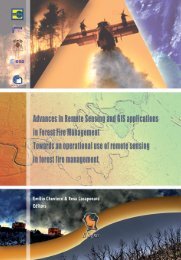Classification of the vegetation in the Virunga National Park (D.R. ...
Classification of the vegetation in the Virunga National Park (D.R. ...
Classification of the vegetation in the Virunga National Park (D.R. ...
Create successful ePaper yourself
Turn your PDF publications into a flip-book with our unique Google optimized e-Paper software.
3.1.3 Soil<br />
A third major factor that affects <strong>the</strong> <strong>vegetation</strong> distribution is soil. Because <strong>of</strong> <strong>the</strong> different periods<br />
<strong>of</strong> volcanic activities <strong>in</strong> both regions, soils <strong>in</strong> <strong>the</strong> western region are very different from soils <strong>in</strong> <strong>the</strong><br />
central and eastern area. Because <strong>the</strong> Nyiragongo and <strong>the</strong> Nyamuraghira have only recently<br />
erupted; <strong>the</strong> soils <strong>in</strong> this region are composed <strong>of</strong> relatively large particles. These soils have low water<br />
retention capacities and this is <strong>the</strong> reason why <strong>the</strong>re are so much hard leaf <strong>vegetation</strong> groups.<br />
3.1.4 Volcanic activity<br />
Because <strong>the</strong> Nyiragongo and <strong>the</strong> Nyamuraghira are still active volcanoes, <strong>the</strong>ir <strong>in</strong>fluence on <strong>the</strong><br />
landscape dur<strong>in</strong>g and after an eruption can be very impressive. The lava fields destroy large areas<br />
<strong>of</strong> <strong>vegetation</strong> where, only after a period <strong>of</strong> time, well adapted plants are able to colonize <strong>the</strong> new<br />
areas. These recent lava fields can easily be recognized on a false colour composite (fig. 2)<br />
Figure 2: False Colour Composite show<strong>in</strong>g lava fields on <strong>the</strong> Nyiragongo and <strong>the</strong> Nyamuraghira.<br />
3.2 Area <strong>of</strong> central and eastern volcanoes<br />
The most important step <strong>in</strong> <strong>the</strong> image classification was to look for <strong>the</strong> right sample pixels. Two<br />
different methods were used <strong>in</strong> this study area. We used <strong>the</strong> two detailed <strong>vegetation</strong> maps <strong>of</strong> C.<br />
Marius (1976). We used <strong>the</strong>se maps as our ground truth by look<strong>in</strong>g for areas we could recognize<br />
both on <strong>the</strong> image and on <strong>the</strong> maps. We used a maximum likelihood classification to classify all<br />
pixels <strong>of</strong> <strong>the</strong> image. The result<strong>in</strong>g map did not give good results, because its <strong>vegetation</strong> pattern<br />
could not be expla<strong>in</strong>ed by <strong>the</strong> four ma<strong>in</strong> factors that <strong>in</strong>fluence <strong>vegetation</strong>. To improve <strong>the</strong> classification,<br />
we tried to <strong>in</strong>terpret <strong>the</strong> image much more thoroughly. We assumed that changes occurred<br />
s<strong>in</strong>ce <strong>the</strong> moment <strong>the</strong> <strong>vegetation</strong> maps were published. By emphasiz<strong>in</strong>g <strong>in</strong>terpretation, <strong>the</strong> result<strong>in</strong>g<br />
classification gave good results. The f<strong>in</strong>al map (fig. 3) showed a normal distribution <strong>of</strong> <strong>the</strong> <strong>vegetation</strong><br />
<strong>in</strong> this part <strong>of</strong> <strong>the</strong> park. Vegetation becomes less dense <strong>in</strong> <strong>the</strong> higher regions; <strong>the</strong> most dense<br />
<strong>vegetation</strong> groups are located <strong>in</strong> <strong>the</strong> lowest regions <strong>of</strong> <strong>the</strong> park. Large swamps were classified <strong>in</strong> <strong>the</strong><br />
crater <strong>of</strong> <strong>the</strong> Karisimbi.<br />
14<br />
J. Verbeken, L. De Temmerman, R. Goossens, Ph. De Maeyer & J. Lavreau
















